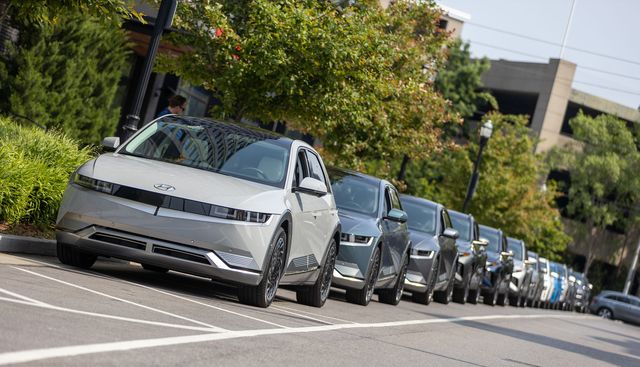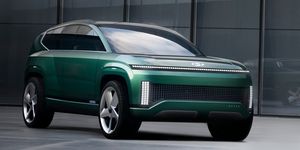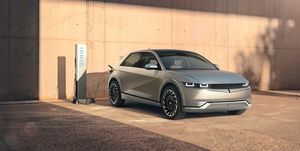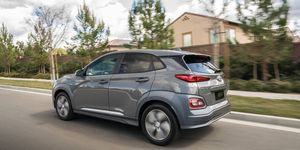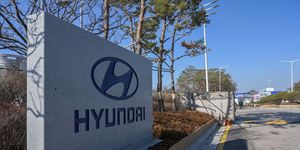- As good as the Hyundai Kona EV is—one of the first affordable battery-electrics in the US with at least 200 miles of range—the Ioniq 5 is even better.
- Based on US demand for the Ioniq 5, Hyundai’s marketing team has a message for the corporate bosses in South Korea: “We need a lot more.”
-
Hyundai plans to have at least 11 battery-electric models on the road by 2030, accounting for at least 1.8 million vehicles annually.
It’s all about electrification at the world’s automakers, and Hyundai has as much to boast about as any of them. The South Korean automaker hosted a recent press event in Nashville that was short on actual product news, but instead the point was to highlight its four vehicles that are taking the brand forward on the road to a zero-emissions future.
We had seat time in two new plug-in hybrids (the Santa Fe and Tucson crossovers) and two battery-electrics (the Ioniq 5 and Kona EV)—all of them enjoyable to drive.
Hyundai shared some of its market research, which helps us understand the business case and its interest in electrified vehicles. Sure, hybrids have been around for more than 20 years, initially selling in small numbers, but they’ve found new life as automakers push aggressively into all things electric. Currently, hybrids, plug-in hybrids and battery-electrics account for about 12% of US car sales, and the share is growing.
Interest in electrified vehicles—as well as sales—is at an all-time high, as Hyundai reports a third of shoppers are most likely to choose something electrified for their next vehicle.
Drilling down further, Hyundai cites Maritz data saying 41% of shoppers probably or definitely would choose a hybrid next, while 37% probably or definitely would go for a battery-electric. The laggard in the group is plug-in hybrids, with only 29% of shoppers leaning in that direction, probably because the battery-electric range is generally very low.
Hyundai plans to have at least 11 battery-electric models on the road by 2030, accounting for at least 1.8 million vehicles annually. Also by 2030, Hyundai Group (including Kia and Genesis brands) is targeting 12% market share for all BEVs sold globally.
Other automakers have stated similar goals, and the next 10 years will reveal which manufacturers have the patience, determination, and the deepest pockets to prevail. Globally, Hyundai Motor says it will invest $16.2 billion in electrification, including $5.5 billion for a new EV and battery manufacturing plant in Bryan County, Georgia.
Hyundai also will be spending heavily on robotics, autonomous driving, air mobility (eVTOLs), and artificial intelligence, but for now let’s focus on the company’s bread-and-butter vehicles. So, what’s it like driving Hyundai’s four newest electrified entries?
As good as the Kona EV is—one of the first affordable battery-electrics in the US with at least 200 miles of range, launching in 2019—the Ioniq 5 is even better. Unlike the mainstream shape of the Kona, the Ioniq 5 is styled to make a statement. With its pixelated rear lighting, futuristic wheels, steeply raked liftgate, and rectangular daytime running lamps, the Ioniq 5 delivers concept-car looks and a sharp angularity hinting at Tesla’s Cybertruck (particularly in the rear quarter panels).
This five-passenger compact crossover also treads new ground in the cabin with intentionally straight lines everywhere: from the door trim and instrument panel to the massive display screen that houses both a 12.3-inch digital cluster and a 12.3-inch multimedia screen, side by side under flat glass, all of it illuminated in calming soft white and gray tones.
Lending familiarity to the Ioniq 5 interior is a straight row of hard buttons under the screen for accessing the map, navigation system, media, and favorites, but the most jarring element might be the steering wheel, which has no Hyundai badging—just four small squares in a straight row, like the pixels on the back of the car. The PRND shifter is tucked neatly (some might say hidden) on a stalk mounted to the right side of the steering column.
The 2022 Ioniq 5 Limited AWD we tested in Nashville came with the 77.4-kWh lithium-ion polymer battery delivering an estimated 256 miles of range from dual motors (range extends to 303 miles with the single-motor version). Having driven rivals such as the VW ID.4, Ford Mustang Mach-E, Polestar 2, and Chevy Bolt, the Ioniq 5 is more than competitive, accelerating effortlessly through a single-speed reduction gear with 320 hp total from the two motors.
Capability like this doesn’t come cheap: Our loaded test model stickered for $56,920. That’s a big step up from the $44,340 Kona Electric Limited we drove with 201 hp from a single motor and 258 miles of range.
From an efficiency standpoint, the Kona EV (which was facelifted this year) was better, traveling an impressive 4.6 miles per kWh during our drive, compared with 3.4 miles per kWh in the Ioniq 5. It’s worth noting eight journalists cycled through each vehicle throughout the day, so multiple driving styles impacted those figures. My drive partner and I were the last group of the day in the Ioniq 5, and we rolled back to the hotel with 86 miles of range remaining—after a total 150 miles had been driven throughout the day. And there was no charging during the lunch break.
Both the Ioniq 5 and Kona EV have been well received in the US market, and the Ioniq 5 is off to a great start, with 6244 deliveries in the first quarter of this year.
For context, the Ioniq 5 is outselling many similar-sized combustion-engine models, including the Buick Envision, Cadillac XT4 and XT5, Genesis GV70, Infiniti QX50, and Volkswagen Atlas Cross Sport, according to Wards Intelligence data. Among battery-electric vehicles, only the Ford Mustang Mach-E and Tesla’s Models 3, S, and Y outsold the Ioniq 5 in the first quarter. The Ioniq 5’s platform mate, Kia’s EV6, is off to a good start as well, with 5281 Q1 deliveries.
Sales for the Ioniq 5 are picking up where the Kona EV left off: First-quarter sales in the US have been a mere 1050 units, but Hyundai sold nearly 9000 Kona EVs in 2021 and a total 16,610 since launching in 2019.
The vast majority of Hyundai’s sales remain gasoline-powered, and the plug-in hybrid versions of the Santa Fe and smaller Tucson are arriving at dealerships now. With a fully charged battery, the Santa Fe PHEV can run in all-electric mode for 31 miles and the Tucson for 33 miles.
Transitions between combustion and electric modes were seamless—barely perceptible—during our test drive in the Santa Fe, our first vehicle of the day, and we observed a whopping 68.7 mpg. By the time we drove the Tucson PHEV, its all-electric range had been depleted, so the fuel economy was less impressive.
Comparing these two drive experiences lays bare the problem with plug-in hybrids: Anyone with a long daily commute or doing lots of highway driving probably won’t see the benefit of a PHEV. But for short driving around town—especially if you’re willing to plug in each night, even with a standard 120-volt wall socket—your plug-in hybrid will barely burn gasoline.
By way of pricing, our 2022 Tucson and Santa Fe PHEVs were both well-equipped Limited AWD models, stickering for $44,640 and $47,450, respectively. For me, the highlight of both these PHEVs was the 1.6-liter turbocharged four-cylinder mated to a six-speed automatic.
It’s the same powertrain in both vehicles and it’s surprising how such a small engine provides so much giddy-up in both these popular five-passenger crossovers, particularly the larger Santa Fe. This engine is ready to jump when throttled, without sounding harried in the process.
If you’re shopping something electrified, take a look at the plug-in hybrids, as well as the Kona EV. You might really want the Ioniq 5, but global demand for it is sky high, which means there’s a long wait list. Based on US demand for the Ioniq 5, Hyundai’s marketing team has a message for the corporate bosses in South Korea: “We need a lot more.”
How do you think Hyundai stacks up in the market with its current electrified vehicles and its plans for the future? Please share your thoughts below.





